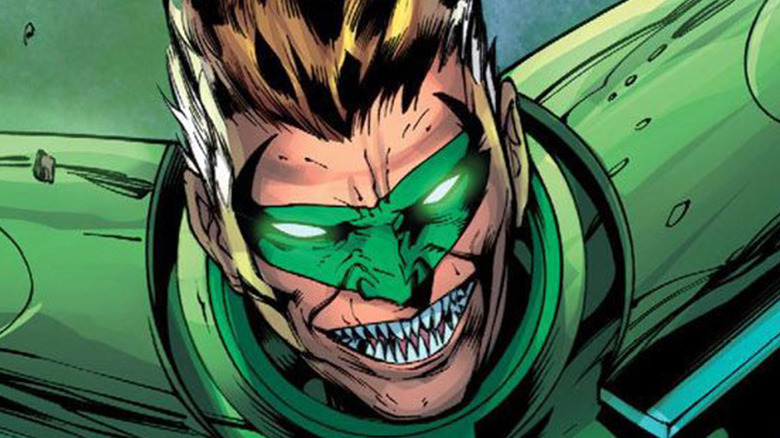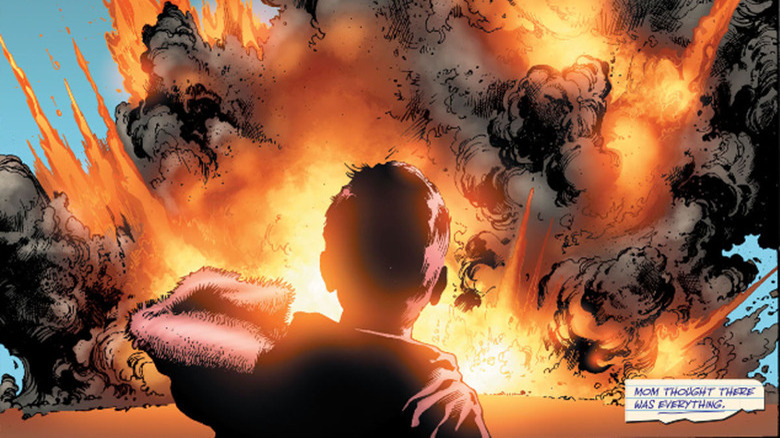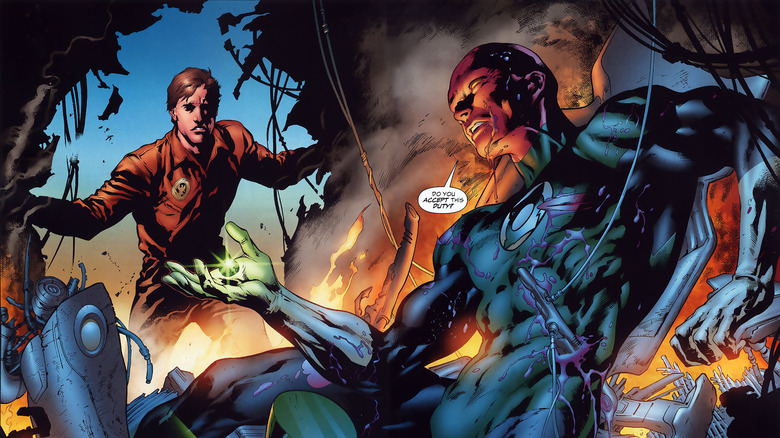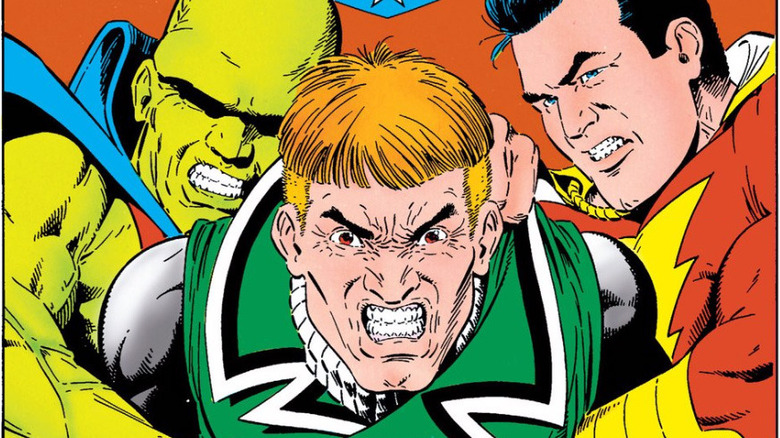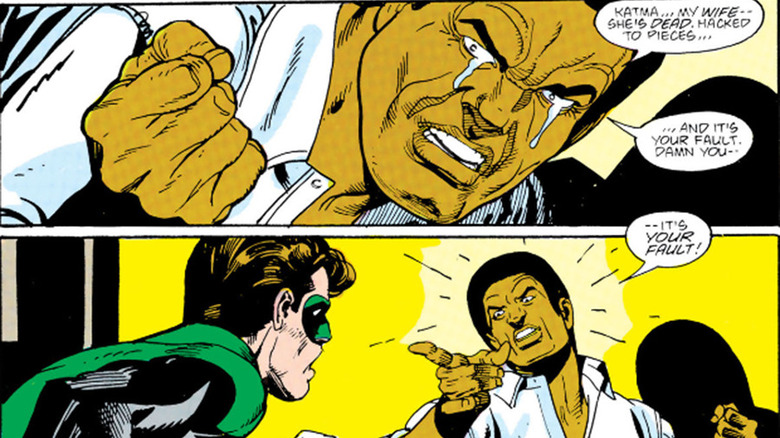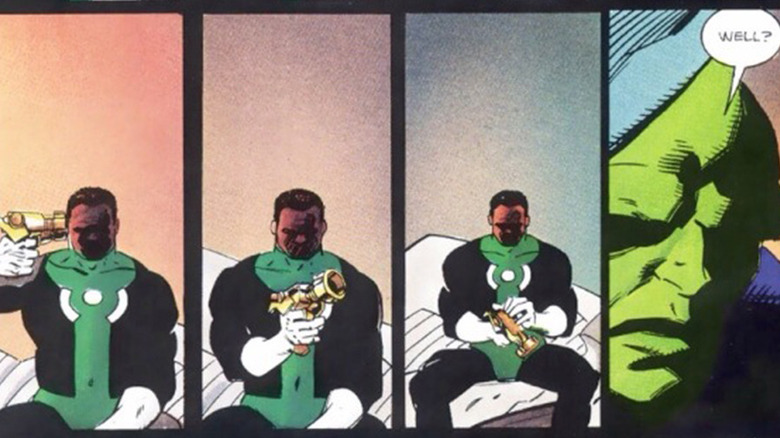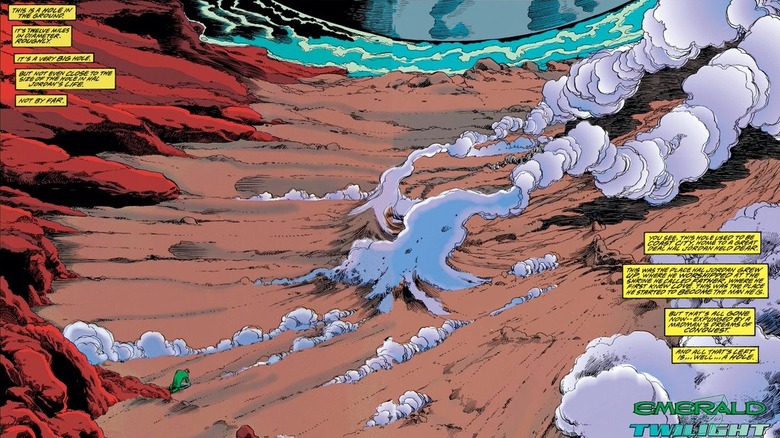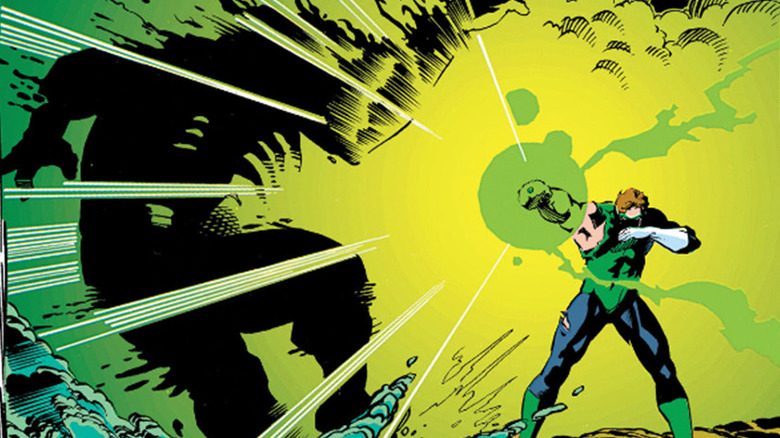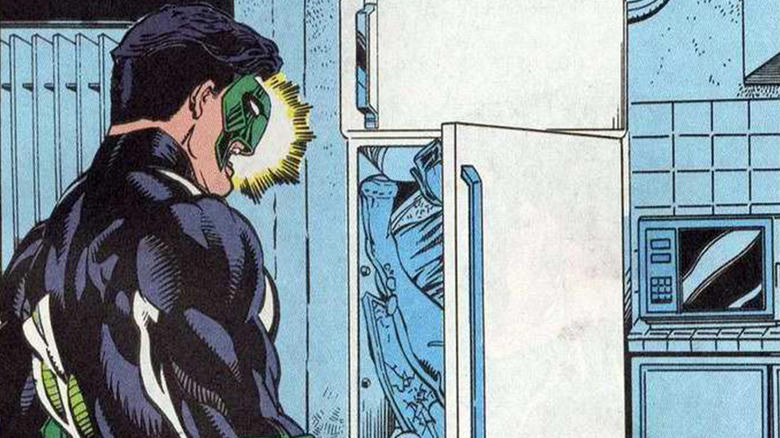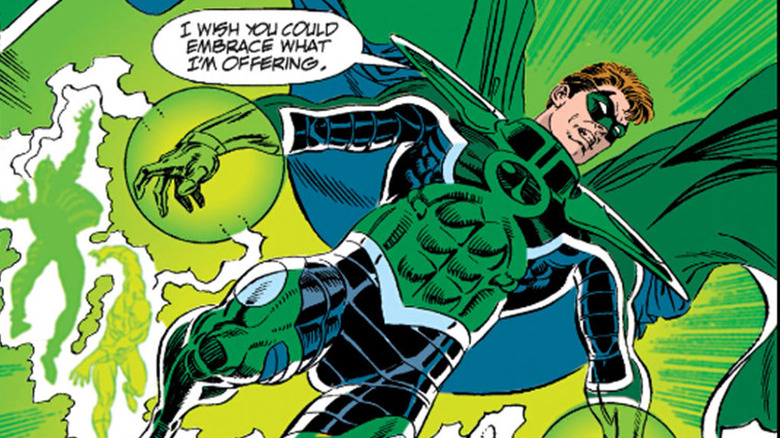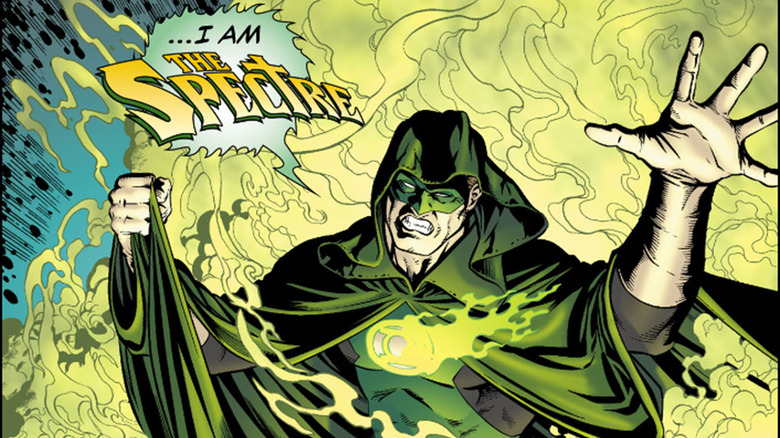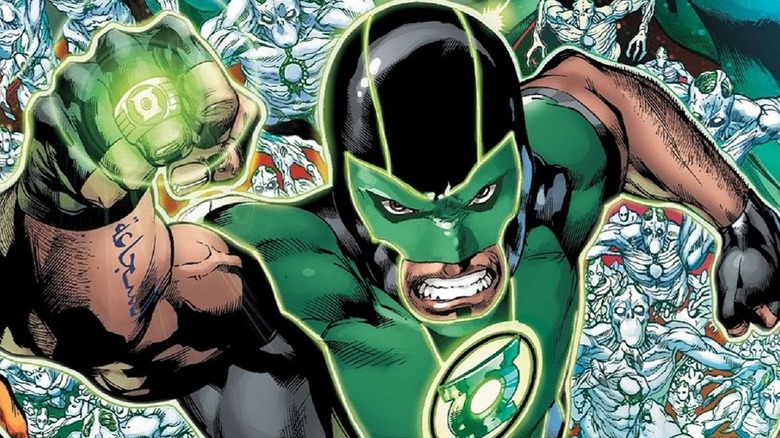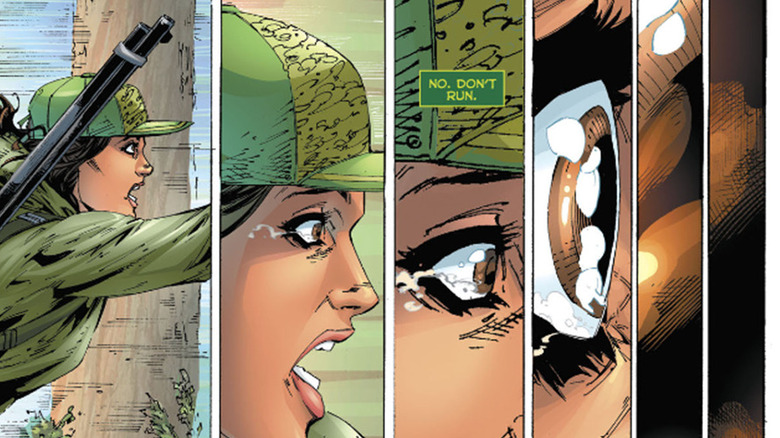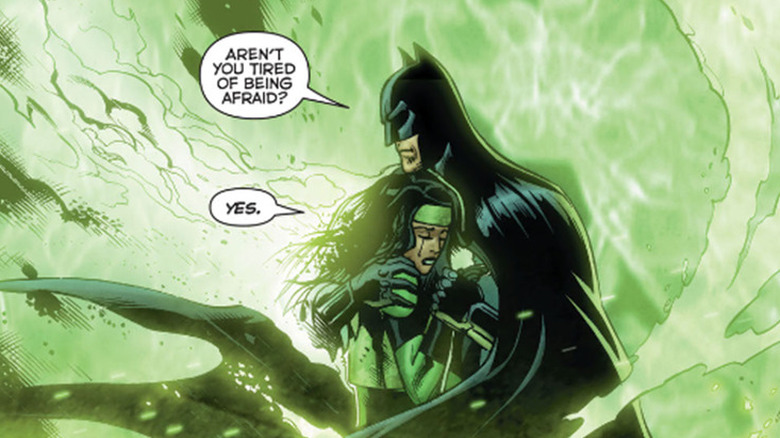The Dark History Of Green Lantern
When it comes to superheroes, few have powers quite as cool as Green Lantern. Alan Scott, DC Comics' original Green Lantern from back in the '40s, can, with his magic ring and, well, green lantern, create almost anything he wants. He fought crime until superhero stories fell out of vogue after World War II, and all but the most famous heroes faded into the dark.
In the 1950s, DC brought Green Lantern back, updated for a modern audience. The new guy, Hal Jordan, is just one Green Lantern in a universe-spanning police force overseen by enigmatic beings dubbed the Guardians of the Universe. Over the years, the mantle of Green Lantern has been passed from hero to hero, put down, stripped away, and picked back up by folks like Hal Jordan, Guy Gardner, and Jessica Cruz.
These days, all of Earth's Green Lanterns are active, healthy, and working together in harmony. That hasn't always been the case, though, as these heroes have fought each other, died, and suffered enough heartache to make a dead planet weep. The sad fact is, for heroes whose powers stem from wielding light, these folks have gone through some dark, dark times. These are the darkest moments in Green Lantern history.
Hal Jordan is shaped by childhood trauma
In choosing a new Green Lantern, the rings themselves pick sentient beings who can "overcome great fear." The thing is, the first of the modern Green Lanterns, Hal Jordan, has no fear to overcome. He's been fearless since he saw his father die in a plane crash as a child. As he recalls in 2005's "Green Lantern" #29, "When your worst fear happens in front of your eyes ... there [is] nothing left to be afraid of."
Hal's dad was a pilot, and he died doing his job. Instead of spending his life terrified of planes, however, Hal decides to do exactly what his father did: On his 18th birthday, he joins the Air Force. But Hal also revels in pushing things a bit too far, totaling planes by forcing them past their test limits and bailing at the last possible second. He gets a reputation for being the most expensive and dangerous pilot in the Air Force, as he tempts death every time he's in the air.
Even after getting a Lantern ring, Hal refuses to wear it when he flies a plane. He doesn't want the safety net, no matter how close he comes to dying the way his father did. Fearless? Maybe. But reckless might be a better word for it. Hal daring death every time he gets in a plane has more than a few shades of undealt-with trauma from his father's death.
Green Lanterns get their rings when the previous wearer dies
How does someone become a Green Lantern? Well, there usually needs to be a death — as in a Green Lantern death. Sometimes Lanterns are stripped of their rings, but most of the time, new ones are chosen as soon as the previous ring owner dies. The rings are programmed to fill vacant spots as quickly as possible, and fly right off the dead Lantern's finger to find a new victim — er, recruit.
That's how Earth's first Green Lantern, Hal Jordan is chosen. When his alien predecessor, Abin Sur, crashes on Earth, Hal inherits his ring. Unlike most Green Lanterns, though, he isn't given the ring after death. Knowing he's dying, Abin instructs his ring to find a replacement. Hal is plucked from the Ferris air field, flown to the crashed alien ship, and bears witness to Abin's death. Once his predecessor has passed, Hal Jordan becomes the Green Lantern of Sector 2814.
The Green Lantern Corps has existed for billions of years. Who knows how many deaths the rings have borne witness to in all that time? Even though the Corps has been wiped out and restarted, new rings have already gone through plenty of new recruits. Heroes are often born of tragedy, but few are so closely bound to death as Green Lanterns.
Guy Gardner is never the same after his mind is broken
Back in 1968, readers met Hal's first backup Green Lantern, Guy Gardner. He had a few adventures, disappeared for awhile, and then came back during DC's "Crisis on Infinite Earths." Afterwards, Guy joins the new Justice League as its Green Lantern ... but as he's a hyper-macho, arrogant, insufferable jerk, no one likes him. When he challenges Batman for leadership of the League In 1987's "Justice League" #5, the vigilante knocks him out with a single punch. Everyone — including the readers — cheers it on.
The thing is, no one seems to be bothered by the fact that Guy hasn't always been a jerk. He disappeared, the comics eventually explain, because he suffered severe brain damage. His superhero duties took a toll, and then his power ring exploded in his face and knocked him into the Phantom Zone. 1979's "Green Lantern" #121 through 123 chronicle this dire period, during which Guy is held prisoner, tortured, and brainwashed by the evil Kryptonian, General Zod.
By the time Hal rescues his Green Lantern pal, the docs aren't sure he'll ever be the same. Guy spends the next seven years comatose in a hospital until he's awakened during the Crisis as a completely changed man. He does calm down as the years go by, and eventually becomes a complex hero we all can love. But Batman knocking out a man with brain damage probably isn't his most heroic moment.
John Stewart's wife is murdered in their home
When you have a job as dangerous as a Green Lantern's, it's always good to have a few replacements in reserve. Hal's second backup is an architect and Marine vet named John Stewart. In time, John becomes the sole Green Lantern of Earth while Hal is away in space. But then, after "Crisis on Infinite Earths," Hal is the only powered Green Lantern left. This suits John fine, and he happily settles down with his wife and fellow former Green Lantern, Katma Tui.
But then, in "Action Comics" #601 through #607, John's life unravels. See, Hal's on-again-off-again girlfriend Carol Ferris is occasionally possessed by an alien crystal: It takes over her personality and turns her into the insane Star Sapphire. Hal is crashing at John and Katma's apartment when Star Sapphire comes looking for him. Katma is the only one around, so Sapphire brutally murders her to send a message.
This goes down in a backup story in an anthology comic, but the panels are powerful, dark, and disturbing. John and Hal find her body covered in cuts on the kitchen floor. The grieving widower forces Hal to "take a good long look" at his dead wife, and declares their friendship over. When he later runs across Carol Ferris, John can't help but lash out, seemingly smothering and killing her. Though Carol survives, Stewart is never the same man.
John reaches his breaking point after letting a planet die
Though John Stewart suffers from PTSD, it mostly doesn't stem from his time as a U.S. Marine. Instead, it's from a Green Lantern incident that happens during the universe-wide crossover event "Cosmic Odyssey," shortly after John loses his wife.
Green Lantern and the Martian Manhunter, J'onn J'onzz, are assigned to protect a planet called Xanshi. John becomes increasingly cocky as he faces down threat after threat, eventually sidelining J'onn, informing the Martian that he can handle things by himself. But, in fact, he can't, and a bomb goes off, destroying the entire planet. J'onn is furious, telling John that he's now had to watch two planets die.
When the crisis has passed, John reaches his lowest point ever. He sends his Power Ring away, apologizes to Katma's memory, and picks up a gun. He sits with it pressed against his temple for five panels, then puts it down. Martian Manhunter has been watching the entire time and comes out of hiding to taunt him for not pulling the trigger. John takes it all in, then calls his ring back, tells the Martian to screw off, and leaves. J'onn smiles, as his horrifyingly blunt reverse psychology gambit has worked. But it doesn't heal the wounds left on John Stewart's soul.
Hal Jordan's hometown is wiped off the face of the planet
The '90s were not kind to DC's superheroes: This is the era in which Bane breaks Batman's back and Doomsday kills Superman. But the unkindest blow is struck against Green Lantern. During the 1993 "Superman" storyline "Reign of the Supermen," two of the hero's enemies, Cyborg Superman and Mongul, blow up Coast City. Coast City had been Hal Jordan's home since he debuted back in 1959. He was born and raised in that city. He learned to love there, to live there, and be a hero there. And then, suddenly, it's gone.
And to be clear, "gone" isn't an overstatement. It isn't just an attack. It certainly isn't a battle. The villains raze the city to the ground while Hal is off in space saving the universe. The only thing left when he returns to Earth is a shattered doll lying at his feet. He's failed to protect the city he swore to keep safe so utterly, there is nothing left but a crater in the ground and ashes blowing away in the wind.
Hal goes mad and turns into a mass murderer
Coast City is just the beginning. First, Hal tries bringing it back with his ring. He recreates his dead father with green light, only to listen to him tell Hal what a disappointment he is. He then recreates buildings, trees, birds, streets, even old lovers –- all of Coast City is soon rebuilt out of green light. But then, Hal's ring runs out of power, and it all disappears. That's when his mind snaps. Unlike John Stewart, Hal's grief doesn't make him self-destructive — it just makes him destructive.
Hal goes on a rampage through space, heading straight for the homeworld of the Guardians of the Universe, Oa. He takes out any Green Lantern who gets in his way. In 1994's "Green Lantern" #49 and #50, friends and allies all become, as Hal himself puts it, "fodder." When he vaporizes his best friend in the Corps, Kilowog, Hal knows there is no turning back.
He enters the Green Lantern power battery in tears, grieving and broken. But when he emerges with all the power of the Corps, the last of his humanity is completely snuffed out. The greatest Green Lantern ever has wiped out a peacekeeping force that has existed for billions of years. Though later stories retcon this arc by putting Hal under the influence of Parallax, the living embodiment of fear, it doesn't change the fact that Hal has committed heinous acts.
Kyle Rayner's first storyline exposes comic book misogyny
After Hal Jordan destroys the entire Green Lantern Corps, only one ring remains. Kyle Rayner inherits it on Earth, and serves for years as the only Green Lantern in the entire universe. When readers first meet him in 1994's "Green Lantern" #48, he's seeing Alexandra DeWitt. Six issues later, the supervillain Major Force murders her and shoves her body into a refrigerator for Kyle to find.
It's an incredibly dark, disturbing moment, which convinces Kyle to stop treating being Green Lantern like a game and start taking it seriously. But it didn't sit well with many folks: In fact, future DC writer Gail Simone took to the web with other comic book readers to create a website called Women In Refrigerators. Here, Simone and her fellow fans critique the disturbing frequency with which comic storylines commit horrible acts against female characters as a means of furthering male characters' storylines.
You'd think DC might have learned a lesson, but they doubled down on the incident in 2010 during the "Blackest Night" storyline. In "Green Lantern Corps" #46, Alex returns as an undead Black Lantern — inside a refrigerator. She pulls Kyle in to relive her murder, going into even more explicit detail on how she was beaten and killed. It isn't just a dark moment in Green Lantern history, but in all of comic book history.
Hal Jordan tries wiping out the entire universe
After stealing all the Green Lantern power for himself, Hal's next order of business is to reshape the world as he sees fit. He messes with time, destroying billions of lives and drawing the attention of the entire superhero community, plus the Spirit of Vengeance himself, the Spectre. Ultimately, Hal decides he has to go back to the beginning of time and restart the entire universe from scratch. It's over-the-top high-stakes superhero drama at its most intense, but it comes to a head in a quiet, heart-wrenching moment in "Zero Hour: Crisis in Time" #0.
After a knock-down, drag-out battle with nearly every superhero ever to exist in the DC universe, the good guys finally triumph. Hal exhausts himself, and one ordinary man — Oliver Queen (aka Green Arrow) — finishes him off. It's a particularly cruel blow to use Green Arrow to end Green Lantern's shining era: The two emerald superheroes teamed up for a while back in the '70s. "He's the closest thing to a brother I ever had," Green Arrow mourns, "but I can't let him do this." He then shoots Hal in the chest with an arrow, and puts an end to his threat for good. Before Hal seemingly disappears from existence, he utters one last, whispered word: "Oliver ... "
Hal has to commit murder to atone for his sins
Hal Jordan returns briefly at the end of 1996's "The Final Night" miniseries to give up his life and save Earth one last time. After death, his soul bonds with the Spectre, and he tries forcing the Spirit of Vengeance to become an agent of redemption. The Spectre serves the will of God (yes, that's God with a capital "G") by killing the wicked and damning them to Hell. But Hal doesn't want to kill anymore — he just wants to make things right. Hal pits his will against God's for as long as he can, but then, in "JSA" #60, he slips when he kills a woman who murdered her abusive husband years before and has been trying to work towards forgiveness.
This costs Hal the power of redemption, and, having rejected vengeance, he is powerless to keep the souls the Spectre has damned to Hell from returning. He begs God for forgiveness, wanting desperately to redeem himself for his sins rather than commit new ones. It doesn't work. "God help me," he prays, before finally accepting the mission of vengeance. He returns the damned to Hell, and gives in to killing the wicked in grisly, macabre ways.
Simon Baz battles Islamophobia and blackmail when he becomes Green Lantern
Simon Baz is one of the most recently christened Green Lanterns of Earth. When Hal and his archenemy Sinestro die (again), their rings fuse together and seek out a replacement. That replacement is Simon, a Lebanese-American man who has grown up in a post-9/11 world in which he is bullied and harassed for being a Muslim. Over the years, Simon grows resentful, angry, and defensive. He loses his job and resorts to street racing and stealing cars for money. Then, in 2012's "Green Lantern" #0, he steals the wrong van. The cops catch him in a vehicle filled with explosives, and he's shipped off to Guantanamo Bay on terrorism charges. It isn't long, though, before Hal's malfunctioning ring finds him, declares him Earth's Green Lantern, and breaks him out.
That all works out for Amanda Waller, the woman behind the Suicide Squad. She wants a Green Lantern to counter Hal (he's come back to life), should she ever have to take down the real League. She blackmails Simon, promising to drop the terrorist charges against him if he joins her, even referring to him in 2013's "Justice League of America" #3 as "the only Green Lantern we'll be able to put on a leash." Waller gets her wish, but when her League collapses, Simon is free to be the hero he was always meant to be.
Jessica Cruz suffers such extreme trauma, she becomes a shut-in
Jessica Cruz is the most recent person to take up the Green Lantern mantle, but she has one of the roughest journeys there. Like Hal, her story begins with trauma and death. Unlike Hal, it doesn't make her fearless. When we first meet Jessica in 2014's "Justice League" #30, she's a terrified shut-in, hoarding food and water as her sister tries to coax her out into the world. It isn't until two issues later that readers learn what happened to her, though the full story isn't fleshed out until 2018's "Green Lanterns" #46.
Years prior, Jessica went out hunting with friends. They came across two men burying a body. Jessica stayed level-headed and in control, and was determined to lead her friends back to the cops to get justice. They never made it: The men tracked them down and killed her friends. Jessica is crushed by survivor's guilt, and is afraid nearly all of the time: She's afraid to tell anyone what happened, afraid the men are out there hunting for her, afraid, even, to leave her apartment. She does overcome that fear, but even after she's been chosen to become a Green Lantern, she struggles with lingering trauma and crippling social anxiety.
Jessica is tortured into becoming a hero
Before Jessica Cruz becomes a Green Lantern, she first joins the Justice League as Power Ring. She has all the same powers as Green Lantern, except her special ring comes from Earth 3, a parallel universe with evil copies of Prime Earth's superheroes. Instead of Green Lantern, there is Power Ring, powered by the Ring of Volthoom. The ring itself isn't a passive tool, but a thinking, hating being that enslaves its terrified wearers. It comes to the main Earth to wreak havoc, loses its Earth 3 host, and seeks out a new one. It finds Jessica.
Volthoom feeds off her terror and trauma, cajoling and taunting her to put the ring on. When she tries fighting back, Volthoom forces itself on her, torturing her until she gives in. Once she does, Jessica has to watch as her body is used to kill people and burn the world down around her. The whole time, the ring belittles her, taunts her, and psychologically abuses her to keep her afraid and under its control. Eventually, the Justice League intervenes and Batman helps Jessica face her abuser and take its power for herself. It works, but until she becomes an official Green Lantern, Jessica has to battle through emotional and psychological abuse every time she uses the Earth 3 ring as a force for good.
